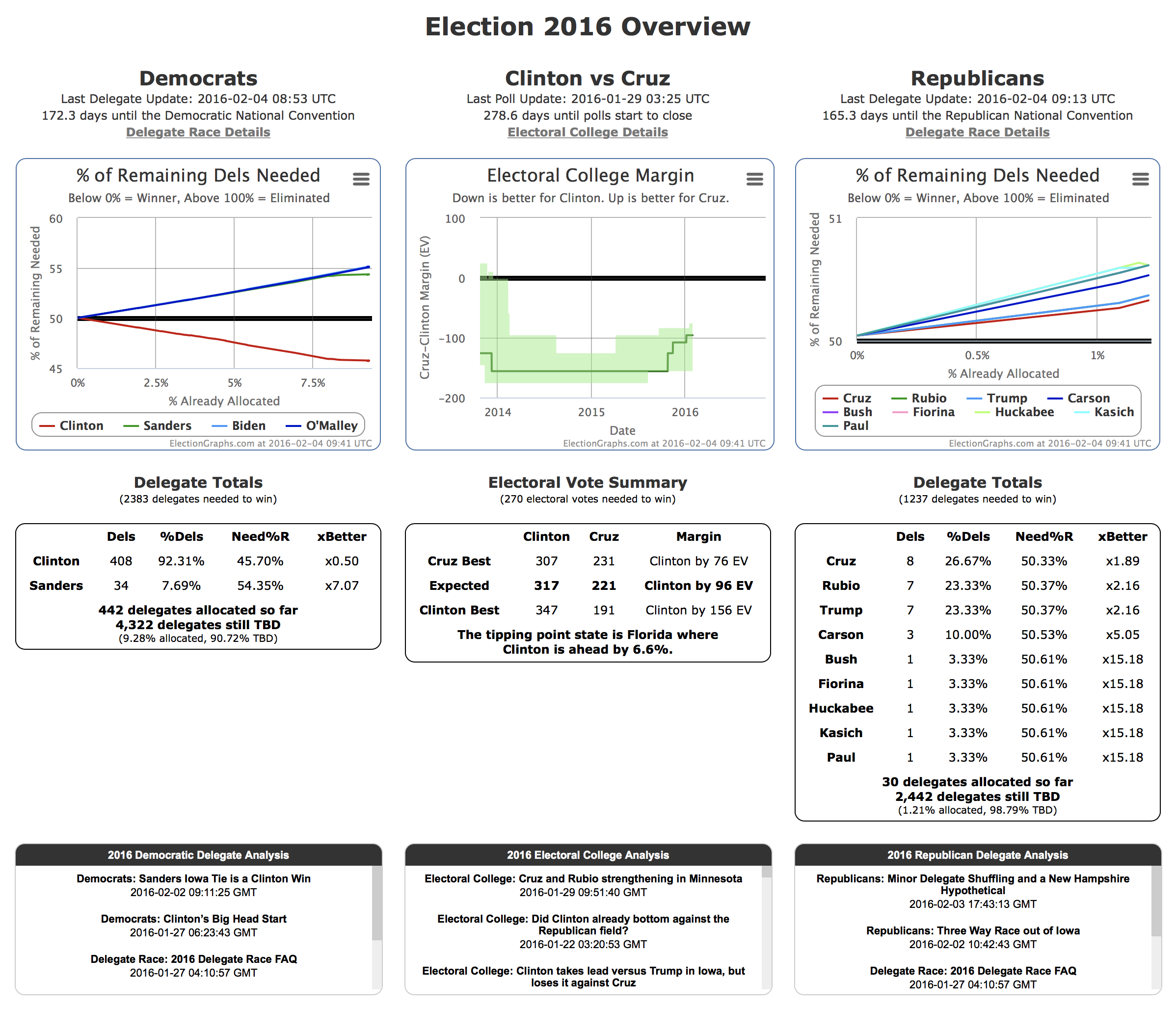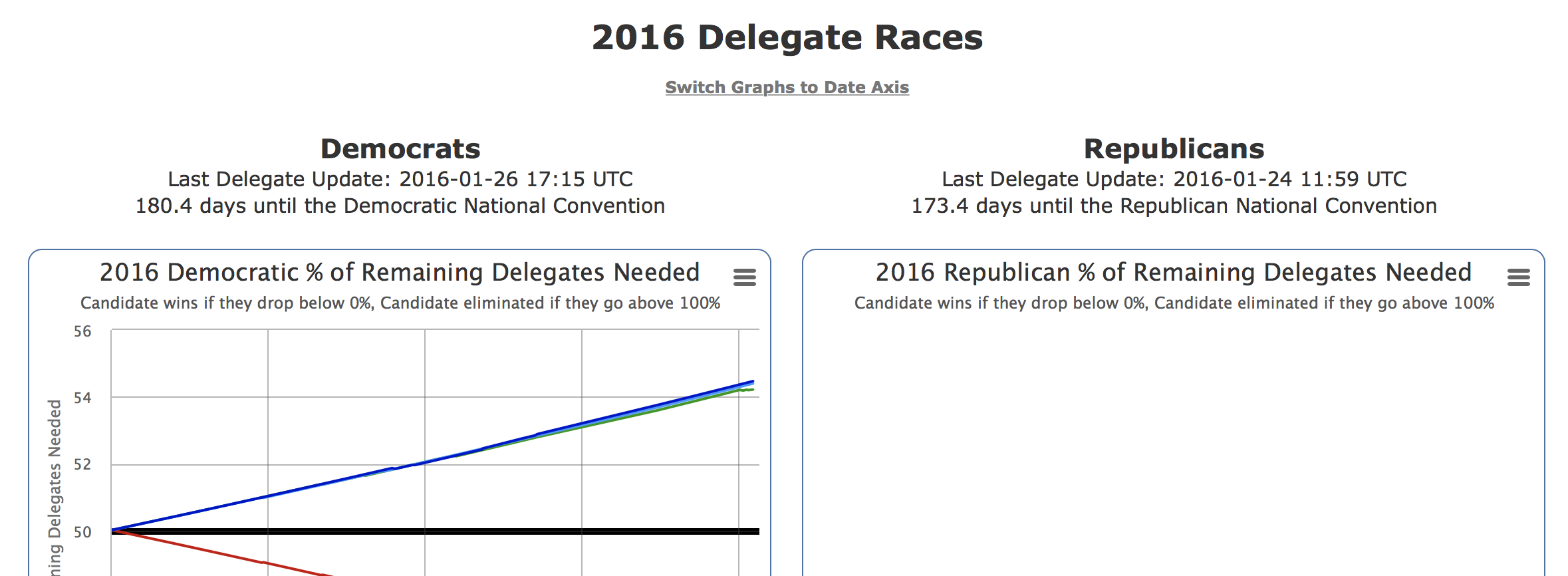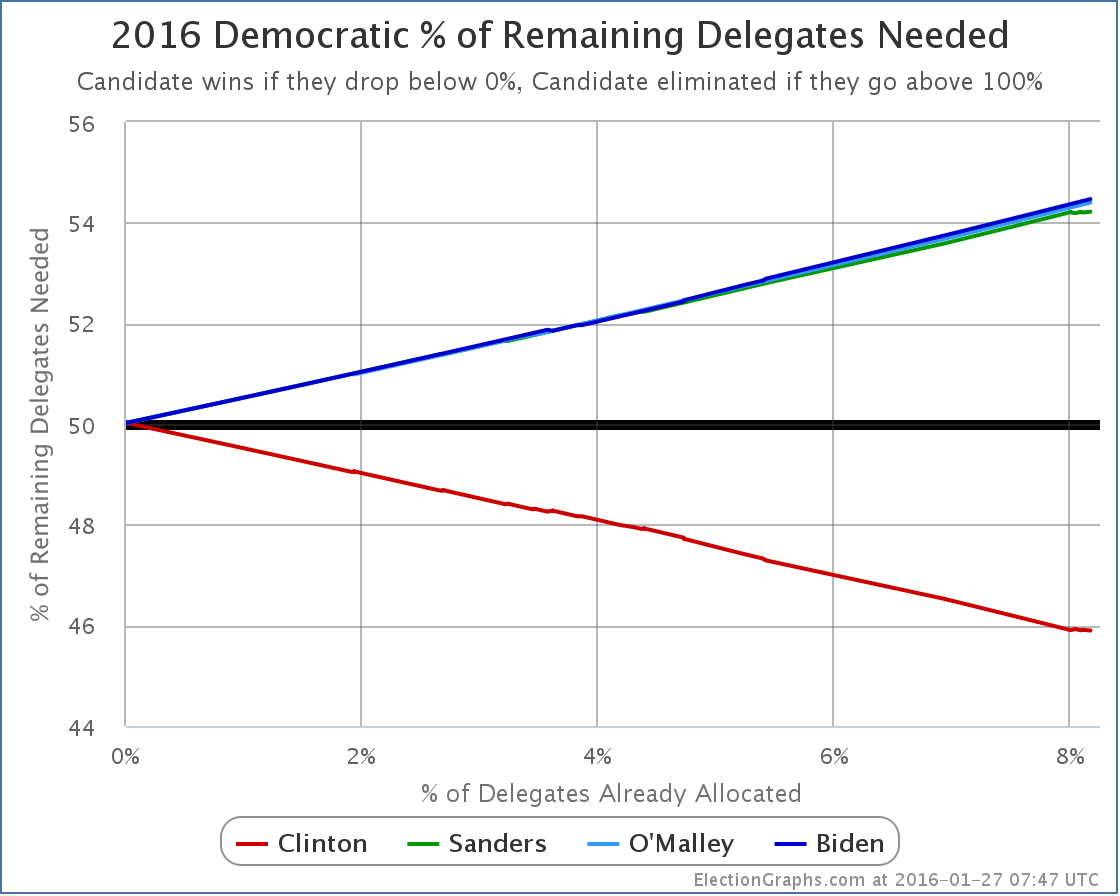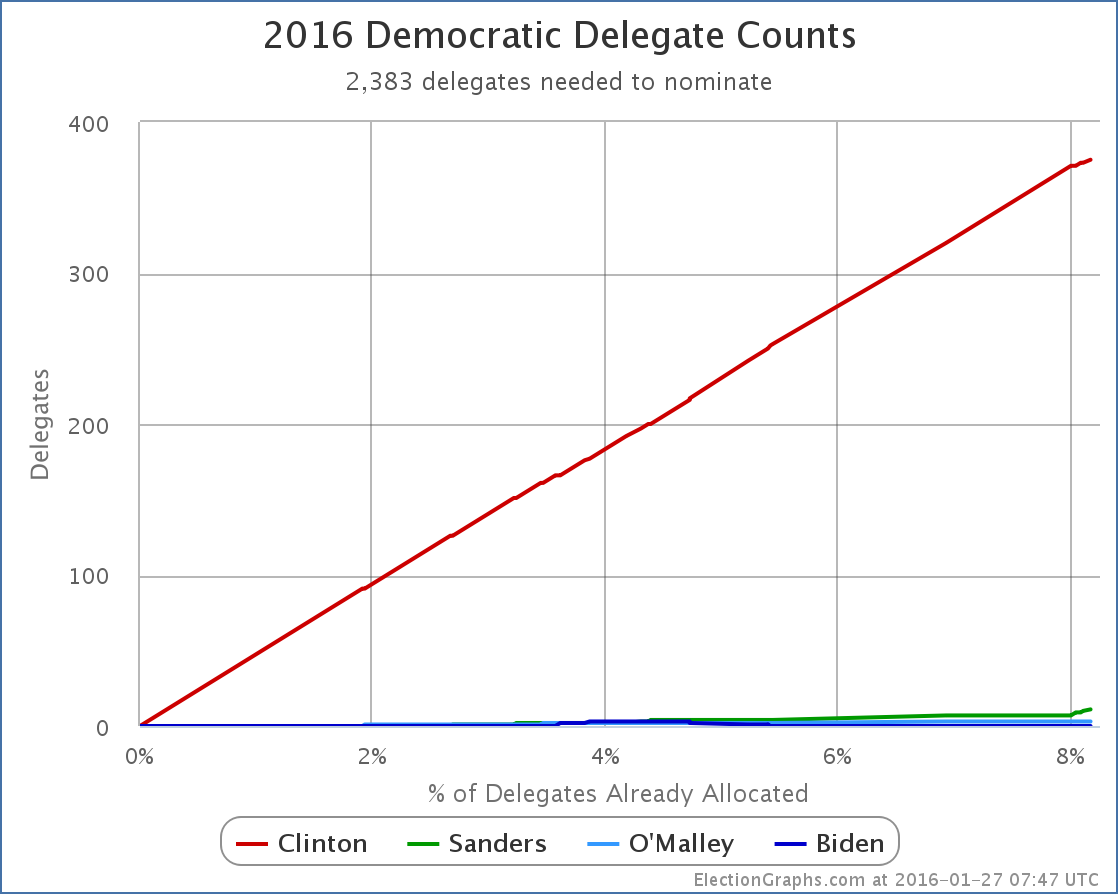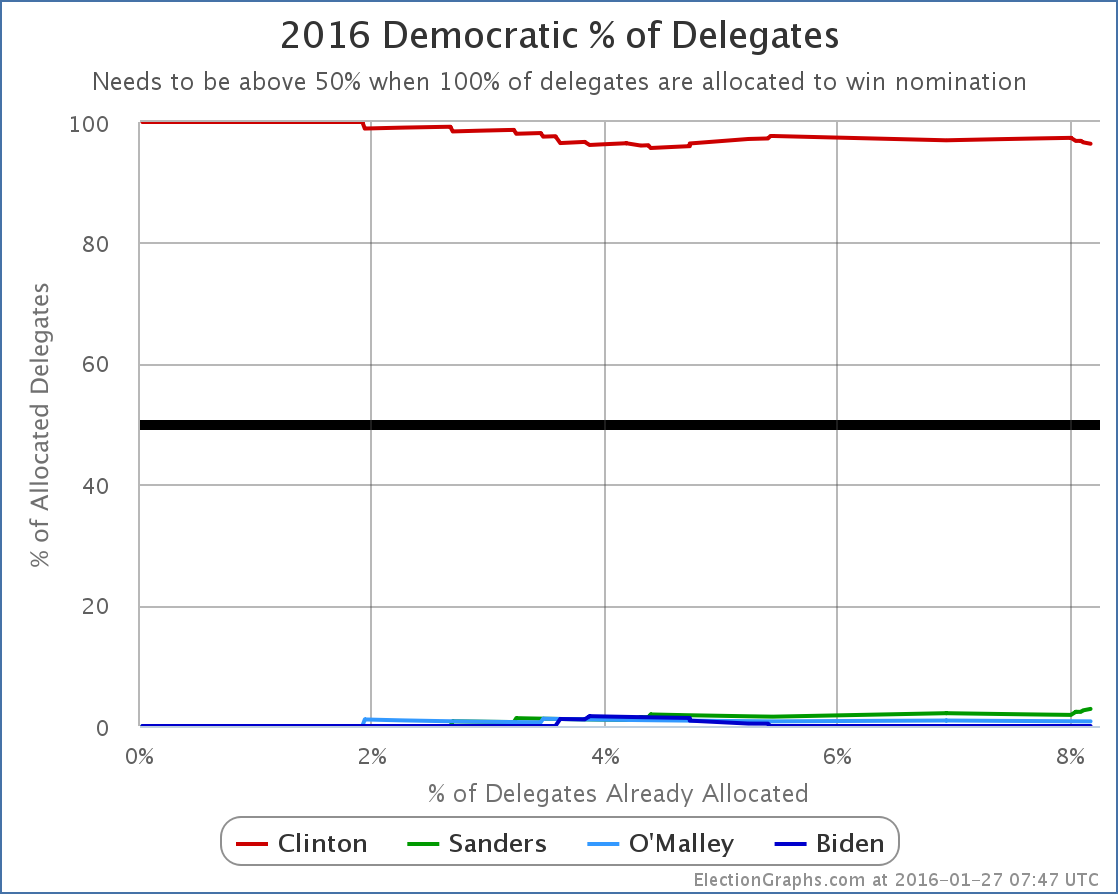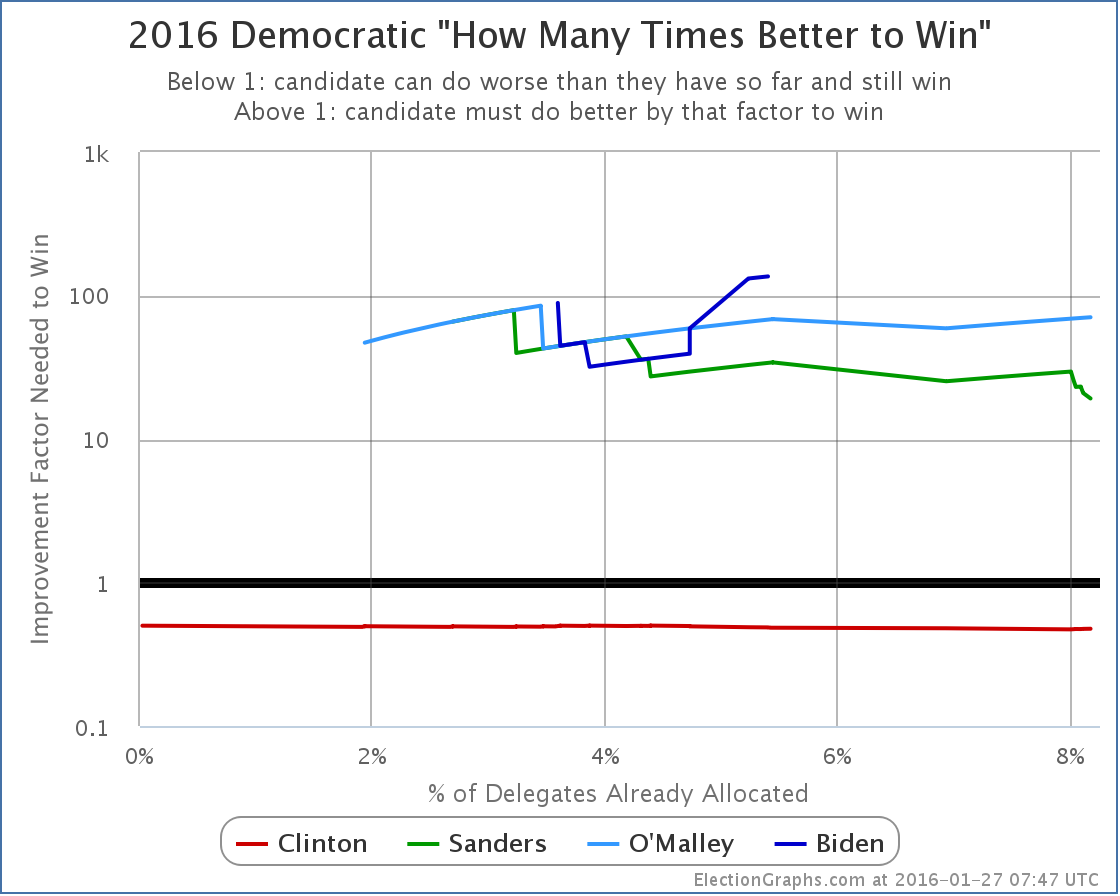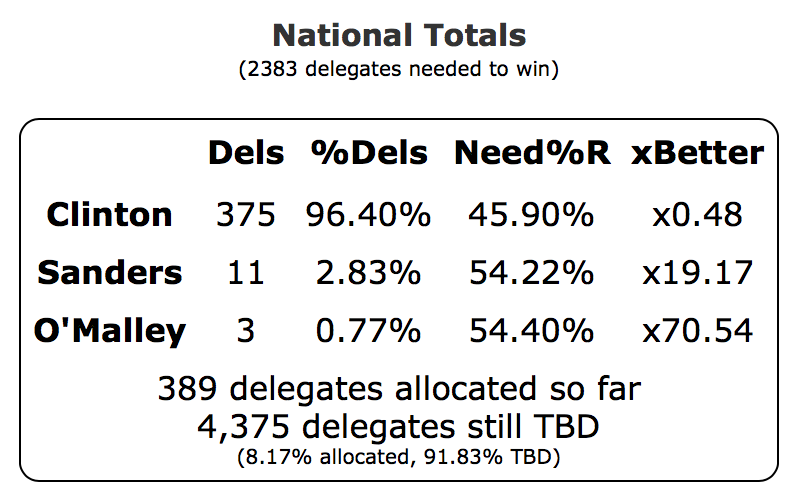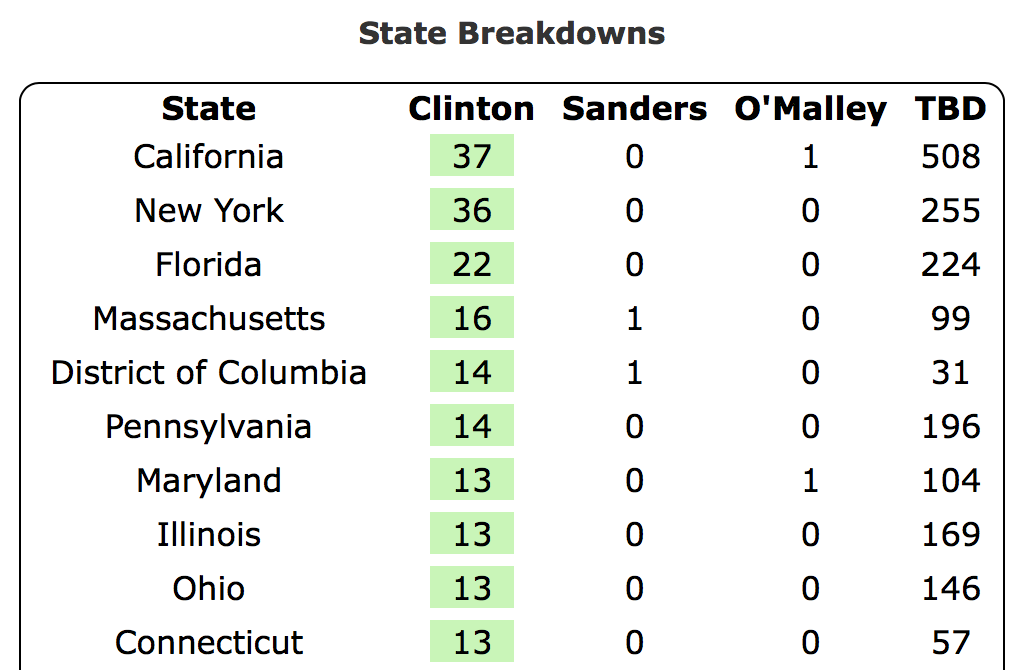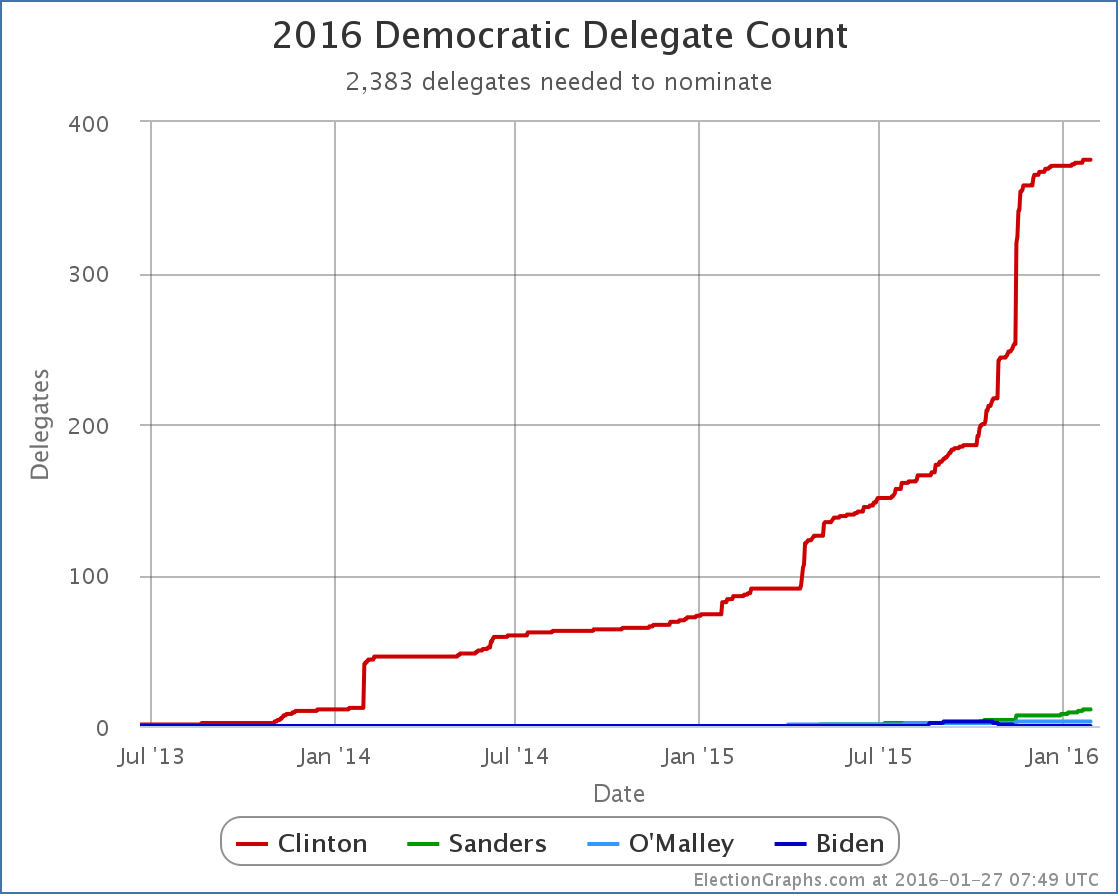This is a FAQ for the 2016 Delegate Race portion of ElectionGraphs.com. The FAQ for the Electoral College portion is here.
Why are you doing this?
Fundamentally, because I have fun with it. But in addition I think I’ve added a couple things beyond the usual delegate tracking you find everywhere in the primary season that are useful and interesting.
OK, what are those things?
First up is tracking the percentage of remaining delegates needed to win. I think this gives a better measure of how the race is going than just looking at the delegate totals alone, because it captures how much harder it is to change the outcome as the race progresses and the frontrunners accumulate delegates.
Second is tracking the various metrics against the percentage of delegates allocated so far, rather than against the date. This gives a better understanding of just how far along the process it is than the date does, since the distribution of delegate allocation “events” is very clumpy, not evenly distributed through the primary season. This is also influenced by when delegates not bound by primary and caucus results make their decisions, which doesn’t happen on any particular pre-set timetable.
Third, rather than concentrating completely on the current delegate counts, I also show the progression of these metrics over time, giving a sense of how things are developing. Now, the past is not necessarily directly predictive of the future, there is always the possibility that campaign events occur that dramatically change the direction of the race, but looking at how things have been going so far, more often than not, gives you an idea of the most probable way things are going to continue.
Why are your delegate counts different than those at my favorite media outlet?
Until delegates actually do the roll call vote at the convention, delegate counting has a lot of uncertainty involved.
While some delegates are directly bound and known based on primary and caucus night results, many others are determined in a variety of ways that make them hard to count. In some cases there is a multi stage delegate selection process. Some outlets choose not to count delegates in these multi-stage processes until the final delegates are known at the last stage of that process. Others, like this site, attempt to determine an estimate of what the final outcome of the process will be based on the results of the earlier stages. These are estimates, and will almost certainly change and shift as the process continues.
In addition, other delegates are actually complete free agents and can vote for whoever they feel like, and can change their minds repeatedly until they cast their actual vote at the convention. Often delegates for candidates that drop out end up in this category as well if they are “released”. Where these delegates publicly express their support for a candidate, this can be used to predict how they will vote, but even in these cases the delegate can still change their mind.
All of the above means that different outlets will make different choices of how to estimate the delegate count, and will have slightly different numbers. The general trends should be similar though.
So are you some kind of expert in the delegate selection process to make these estimates?
No. Not at all. Many years ago I was a physics major. These days I work at a Seattle tech company. I have no particular expertise in this other than being an interested amateur. My estimates though are for the most part not made by me trying to directly estimate numbers from my own reporting. I consult a number of different sources of information on delegate outcomes and try to come up with numbers that use the best available information from those sources.
OK, so what are those sources?
As I launch the delegate tracker a little less than a week before Iowa, my primary sources so far have been Green Papers, FiveThirtyEight, Wikipedia, and the sites they link as references. Some other sources have also been consulted though, and as the actual contests get underway, I expect I will find information in a variety of other places. If you really want to dig into the details, I include reference notes in my raw delegate data files for the Democrats and Republicans as updates are added.
Doesn’t the fact some delegates can change their minds invalidate the “% of remaining delegates” metric?
Well, it does mean that it is really “% of remaining delegates if none of the already allocated delegates change their mind or were estimated incorrectly”, but in practice in recent contests, this hasn’t made a huge difference. But yes, it is always the case that there can indeed be changes of this sort, and you can imagine situations where this would end up being quite significant. For instance, if the front runner were to have an unexpected health issue, dropping out of the race and releasing all of their delegates half way through the primary season, then of course everything gets scrambled. But even events like this would be nicely represented in the graphs, with the % of delegates allocated moving backwards, and the “% of remaining needed to win” changing appropriately. Absent a dramatic event of that sort though, delegates changing their minds is a minor secondary effect, and the estimates in multi-stage processes are often “close enough”, so these factors are unlikely to have a huge effect on the charts.
Do you come at this with some sort of political bias?
Well, of course. Everybody has some sort of opinion and I do have feelings on the presidential race, both in the primaries and in the general election. When it comes to Election Graphs and the commentaries I post when I make updates to either the Delegate Race numbers or the Electoral College estimates, I try my best to be objective and talk mostly about the numbers, and the implications of the numbers on the results. If you want to hear my less objective and more opinionated thoughts on what is going on, and what should be going on, listen to the podcast I cohost: Curmudgeon’s Corner. I often talk about the objective analysis there too course, but my cohost Ivan and I are not constrained by that. In my actual charts and graphs though, and on the update commentary blog posts, I try to stick to what the numbers are saying.
How often is the data updated?
I have a day job and a family, so my time is often somewhat constrained, but I will try to at the very least do an update within 24 hours of the results being released after each major primary or caucus. In the 2008 and 2012 cycles I did a daily scan for new delegate updates even when there wasn’t a major contest, and would do a post if any numbers changed. (Often they wouldn’t, but I checked every day.) I can’t commit in advance to that daily cycle. It will be a goal, but if life gets in the way, I may miss some days. But certainly when there are new primary and caucus results, I will try to get them included as quickly as possible. I generally won’t do more than one update per day though. So when results are still in flux on election nights, I may choose to wait a bit to post the update, so as to get the best numbers possible.
You’ve done this before?
I started doing electoral vote and delegate tracking online in 2008. You can check out the results from both 2008 and 2012 here.
This is awesome, I’d like to share this or mention it in my own online space, can I?
All of the Election Graphs pages, as well as my blog post commentaries, are released with a Creative Commons Attribution-NonCommercial-ShareAlike 4.0 International license. Feel free to reuse this material within those constraints, although I would appreciate a heads up that you are planning to do so.
For other possible uses or to discuss anything else about this site, please contact Election Graphs via Twitter. That is probably the best way to get my attention quickly rather than having an email lost in my inbox or spam folders.
In terms of sharing on social media (or other media)… of course! That would be great! You may also want to follow @ElectionGraphs on Twitter, or like the Election Graphs Facebook Page. In fact, please do!
This sucks, what a waste of time, you are obviously just a shill for <insert candidate you don’t like>… How can I tell you how awful you are?
I welcome and would love to hear from people who have constrictive criticism about the site, want to discuss methodology, or just want to chat civilly about the implications of the numbers shown on the site. But if you just want to yell at me… do you really have to? It just wastes everybody’s time. If you don’t like the site, don’t visit. But if you do need to make comments like the above, there are places to do that. The links to Facebook and Twitter are above, and comments are open on abulsme.com as well.
Note: This post is an update based on the data on ElectionGraphs.com. Election graphs tracks both a poll based estimate of the Electoral College and a numbers based look at the Delegate Races. All of the charts and graphs seen in this post are from that site. Additional graphs, charts and raw data can be found there. All charts above are clickable to go to the current version of the detail page the chart is from, which may contain more up to date information than the snapshots on this page, which were current as of the time of this post. Follow @ElectionGraphs on Twitter or like Election Graphs on Facebook to see announcements of updates or to join the conversation. For those interested in individual general election poll updates, follow @ElecCollPolls on Twitter for all the polls as they are added.
